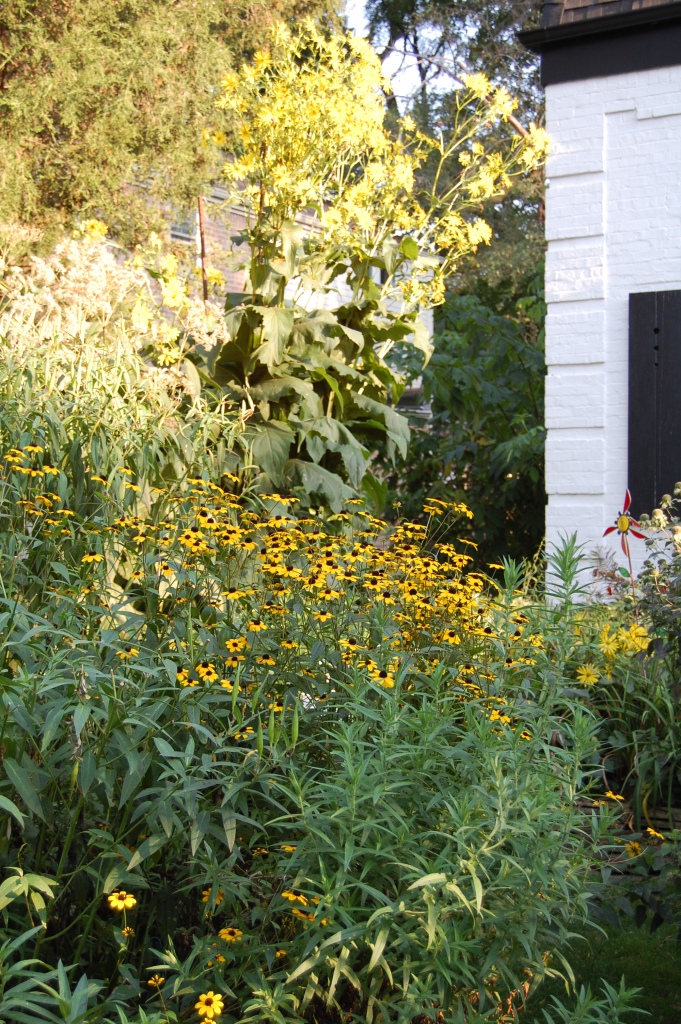My Favorite Susan
These are the days of the blooming Susans, members of the genus Rudbeckia. There’s the Black Eyed Susan generally grown as an annual or biennial (Rudbeckia hirta). Then there’s another Black Eyed Susan, a perennial that also goes by the common name Orange Coneflower (R. fulgida) and which has produced the ever popular variety ‘Goldsturm’.

All the Susans have daisy-like flowers with black centers and “petals” that are generally god/orange/yellow (R. hirta has a greater variety of colors). The centers are actually made up of tiny, tightly packed disc flowers, while each one of the petals is a sterile ray flower.

My favorite Susan, however, is Brown Eyed Susan (R. triloba). This Susan is taller (usually 4-5′) and sometimes benefits from cutting back around late May to keep it more compact. What’s striking about Brown Eyed Susan are the flowers, which are smaller with oval petals. However, they are produced in far greater profusion than those of the other Susans, creating a cloud-like effect.
She is also a long-blooming plant, generally starting for me in August and lasting into October.

But the other thing about Brown Eyed Susan is that it seems to grow almost anywhere. It does well in sun or shade, in moist soil or dry (though much shorter in dry). One year I had a self-sown R. triloba that grew and bloomed enthusiastically at the base of a large Siberian Elm (Ulmus pumila).

This Susan tends not to be long-lived, but she self-sows, as they say, freely. This doesn’t really create a problem, as the seedlings are easy to pull or transplant.
In addition to pleasing people, this Susan (like the others) will attract butterflies and goldfinches. She is native to a wide swath of the eastern and central USA.
What is your favorite Susan?






She’s not my favorite and not even a Rudbeckia, but if I was “Desperately Seeking (another) Susan, I would add the climbing Susan: Black Eyed Susan Vine (Thunbergia alata) and her many cultivars.
BTW, my R. fulgida ‘Goldsturm’ is living up to her cultivar name this year by providing a “storm’ of gold color throughout. I have four clumps and they are double the size of their first blooming season in the Fall of 2012. When they die back this winter I may just divide the clumps and spread the wealth. Goldsturm is one dependable Susan, perhaps not the most exotic perennial, but surely a great girl for late summer and early fall color.
“Desperately seeking…” That’s good, I should have thought of that. Thunbergia is an attractive vine, but has never grown well for me.
Brown, also!
We could start the American Brown Eyed Susan Society to promote appreciation of R. triloba.
I’ve often thought someone should!
It would have a nifty acronym – ABESS.
Looks great with the hyssop! I really need to try this one, I’ve admired it from afar for too long. Are you familiar with r. triloba “prairie glow”? If not check it out, all the good of the species with a bigger brown eye.
I’ve heard of prairie glow but have never seen it.
Rudbeckia say “full-on summer” to me. I have Rudbeckia triloba blooming right now, with those pretty, bright little flowers. It’s the best flower scale for my limited space, but I love spotting any Rudbeckia in other gardens. Yours look fabulous!
Of course I didn’t mention all those other Rudbeckias – laciniata, subtomentosa, etc. I don’t think they are referred to as Susan, though. Wonder why?
Hey Jason,
Sorry to be a buzz kill but I’ve been enthralled with some brown eyed girls but their names didn’t sound anything like Ruby Beckia. ‘Goldstrum’ has become so pedestrian and when not cut back in winter, particularly in mass plantings, it does literally look like hell warmed over.
If I want a yellow punch (which with pink are my least favorite colors) I prefer a well-pinched Ratibida pinnata, the yellow coneflower. I love the architectural feel of what almost appear as golden shuttlecocks (I need to write catalog descriptions???) I know we need yellow to bring all the other colors in our individual palettes together. But it’s just too easy for rudbeckia to go ballistic and next thing you know. all you notice is uncontrollable yellow.
Patrick, you may not disparage my Susan and expect to escape unscathed! Seriously, Ratibida pinnata is great but its structure is very vertical, whereas Rudbeckia triloba is more of a mass and you get that cloud effect. The Rudbeckias do self-sow but that’s why they invented weeding – and passalong plants!
I just love all of the “Susan’s”. A few years ago, every Black-eyed Susan other area stopped coming back after thriving for years. Never could figure out what happened. I am growing a gorgeous R. fulgida that hopefully will continue to thrive. I love the Brown Susan and may have just the spot for it, if I can find one. As an aside, my Westie’s AKC name is Black-Eyed Daisy, kind of an homage to a favorite flower, but recognizing her white color
I never heard of Rudbeckias just dying off like that. I have no idea what would cause it. Probably lightning will not strike twice! I’m sure you would love the R. triloba.
I’ve seen some succumb to powdery mildew with very little warning and in a very short time, with symptoms so mild as to be easy to miss. It appears there are two different selection of R. fulgida in cultivation under the name Goldstrum. One is resistant.
I haven’t seen that with powdery mildew, though I have seen something that looks more like black spot. It defoliates the plant by late season, but is not fatal.
Also I would like to have a big garden … maybe someday I will 🙂
I hope you do!
They are such cheery flowers aren’t they. I love them and enjoyed finding out more about them.xxxx
Looking at them usually puts me in a good mood.
Does your wife know? 😀
When it comes to flowers, we have an open marriage.
I like them all but the brown eyed Susans can’t be beat for quantity of blooms.I think the native black eyed Susan (Rudbeckia hirta) blooms longer than any other flower.I saw the first one on June 29th this year and just took a photo of another one yesterday.That’s nearly two full months of blooming.
R. trloba is pretty good for length of bloom also, starting in early August and lasting until early october.
I agree, there is something special about Rudbeckia triloba…it just has that wonderful, airy quality…I adore it and encourage it to reseed all over the place…and luckily, as you mentioned, it is easy to move 🙂
Yes, my friends are getting tired of me offering them young R. triloba plants.
I have R. hirta, and I agree with N.H. Garden Solutions–it blooms all summer and into fall. Plus, it attracts pollinators all season long, which is great as a companion plant in my veggie garden. When other flowers come and go, it just keeps on blooming. Only bad thing is, the cut flowers don’t last long. But I enjoy all the Rudbeckias!
At some point I would like to plant some ‘Herbstonne’.
Jason, your Susan is pretty! I love these flowers in front garden. Unfortunately Susan doesn’t grow in my garden, doesn’t like the soil.
Interesting. Do you have very acidic soil?
The only Susan I have room for is Black-eyed in hanging baskets and I do love them. Though this year I got an odd “No-eye” with white flowers. I call it Albino Susan.
Huh, never heard of these flowers in hanging baskets or of Albino Susans.
They’re all lovely, but I have another favourite Susan – my sister! I did have a R. fulgida once, but it didn’t survive the extremely hot and dry summer we had that year. I have recently seen R. hirta seeds on sale called “Herbstwald” but resisted the temptation to try them.
Well, without doubt your sister is the best Susan.
All your Susans looks so summery and happy! It’s hard not to love the ‘classic’ susans, but my current fave is R. Henry Eilers (even tho’ I planted it at the front of the bed and it’s going on 6′ tall; I failed to read the tag before planting).
Reading the tag is so boring.
Love seeing these late summer fireworks in other people’s gardens but they never seem happy in the crowded conditions in my beds so don’t stay long for me.
R. triloba takes a lot of shade and crowding, if the look fits you might want to give it a try.
I too love the Susans. Mine are in full, abundant, glorious bloom at the moment. Next year I will try the brown Susans. I like the idea of a taller one.
Because of the size and shape this species can fill a very different niche in the garden.
You seem to be having lots of Susan in your garden. Hope your wife is not jealous ;-). Jokes apart, I love susan too — any Susan will do for me. They are just gorgeous.
A blogger friend in the US sent me some temperate seeds which include the coneflowers. Out of the 14 types, only 6 germinated, and from there only 3 acclimatized successfully to flowering. Coneflowers didn’t make it.
I think this is the Susan that appeared mysteriously in my garden one year. She has come back for a couple years now and is a welcome volunteer. I agree it produces a cloud of blooms that lasts for months.
I love your planting schemes with this plant Jason. very inspiring!
I love them all especially the ones with multi colored flowers especially the orange and brown coloring. I do love Tribola and Henry Eilers as well.